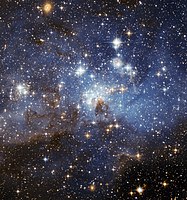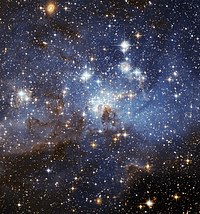
Turbulence and star formation efficiency in molecular clouds: solenoidal versus compressive motions in Orion B
Sign Up to like & getrecommendations! Published in 2017 at "Astronomy and Astrophysics"
DOI: 10.1051/0004-6361/201629220
Abstract: Context. The nature of turbulence in molecular clouds is one of the key parameters that control star formation efficiency: compressive motions, as opposed to solenoidal motions, can trigger the collapse of cores, or mark the… read more here.
Keywords: star formation; molecular clouds; formation efficiency; formation ... See more keywords

Gas phase Elemental abundances in Molecular cloudS (GEMS) II. On the quest for the sulphur reservoir in molecular clouds: the H2S case.
Sign Up to like & getrecommendations! Published in 2020 at "Astronomy and astrophysics"
DOI: 10.1051/0004-6361/201937180
Abstract: Context Sulphur is one of the most abundant elements in the Universe. Surprisingly, sulphuretted molecules are not as abundant as expected in the interstellar medium and the identity of the main sulphur reservoir is still… read more here.
Keywords: molecular clouds; chemistry; sulphur; abundance ... See more keywords

The structure and characteristic scales of molecular clouds
Sign Up to like & getrecommendations! Published in 2020 at "Astronomy and Astrophysics"
DOI: 10.1051/0004-6361/202038849
Abstract: The structure of molecular clouds (MCs) holds important clues on the physical processes that lead to their formation and subsequent evolution. While it is well established that turbulence imprints a self-similar structure to the clouds,… read more here.
Keywords: variance spectrum; molecular clouds; delta variance; structure ... See more keywords

ALMA resolves giant molecular clouds in a tidal dwarf galaxy
Sign Up to like & getrecommendations! Published in 2020 at "Astronomy and Astrophysics"
DOI: 10.1051/0004-6361/202038955
Abstract: Tidal dwarf galaxies (TDGs) are gravitationally bound condensations of gas and stars formed during galaxy interactions. Here we present multi-configuration ALMA observations of J1023+1952, a TDG in the interacting system Arp 94, where we resolve… read more here.
Keywords: molecular clouds; giant molecular; tidal dwarf; gas ... See more keywords

Low Mass Stars as Tracers of Star and Cluster Formation
Sign Up to like & getrecommendations! Published in 2022 at "Publications of the Astronomical Society of the Pacific"
DOI: 10.1088/1538-3873/ac4c9c
Abstract: We review the use of young low mass stars and protostars, or young stellar objects (YSOs), as tracers of star formation. Observations of molecular clouds at visible, infrared, radio and X-ray wavelengths can identify and… read more here.
Keywords: formation; mass stars; low mass; molecular clouds ... See more keywords

The distances to molecular clouds in the fourth Galactic quadrant
Sign Up to like & getrecommendations! Published in 2020 at "Monthly Notices of the Royal Astronomical Society"
DOI: 10.1093/mnras/staa1827
Abstract: Distance measurements to molecular clouds are essential and important. We present directly measured distances to 169 molecular clouds in the fourth quadrant of the Milky Way. Based on the near-infrared photometry from the Two Micron… read more here.
Keywords: molecular clouds; distances molecular; galactic quadrant; clouds fourth ... See more keywords

CO-to-H2 conversion and spectral column density in molecular clouds: the variability of the XCO factor
Sign Up to like & getrecommendations! Published in 2020 at "Monthly Notices of the Royal Astronomical Society"
DOI: 10.1093/mnras/staa2056
Abstract: Analyzing the Galactic plane CO survey with the Nobeyama 45-m telescope, we compared the spectral column density (SCD) of H$_2$ calculated for $^{12}$CO line using the current conversion factor $X_{\rm CO}$ to that for $^{13}$CO… read more here.
Keywords: molecular clouds; conversion; density; column density ... See more keywords

Water ice deposition and growth in molecular clouds
Sign Up to like & getrecommendations! Published in 2020 at "Monthly Notices of the Royal Astronomical Society"
DOI: 10.1093/mnras/staa3578
Abstract: In interstellar clouds, the deposition of water ice on to grains only occurs at visual extinctions above some threshold value (Ath). At extinctions greater than Ath, there is a (near-linear) correlation between the inferred column… read more here.
Keywords: molecular clouds; water ice; deposition; ath ... See more keywords

Solenoidal turbulent modes and star formation efficiency in Galactic-plane molecular clouds
Sign Up to like & getrecommendations! Published in 2022 at "Monthly Notices of the Royal Astronomical Society"
DOI: 10.1093/mnras/stac1812
Abstract: It is speculated that the high star-formation efficiency observed in spiral-arm molecular clouds is linked to the prevalence of compressive (curl-free) turbulent modes, while the shear-driven solenoidal (divergence-free) modes appear to be the main cause… read more here.
Keywords: turbulent modes; formation efficiency; molecular clouds; formation ... See more keywords

Cosmic ray-driven magnetohydrodynamic (MHD) waves in magnetized self-gravitating dusty molecular clouds
Sign Up to like & getrecommendations! Published in 2023 at "Monthly Notices of the Royal Astronomical Society"
DOI: 10.1093/mnras/stad1011
Abstract: The impact of galactic cosmic rays (CRs) in terms of CR pressure and parallel CR diffusion has been investigated on the low-frequency magnetohydrodynamic (MHD) waves and linear gravitational instability in the typical dusty plasma environment… read more here.
Keywords: mhd waves; mhd; instability; molecular clouds ... See more keywords

Line emission from filaments in molecular clouds
Sign Up to like & getrecommendations! Published in 2023 at "Monthly Notices of the Royal Astronomical Society"
DOI: 10.1093/mnras/stad1229
Abstract: Filamentary structures are often identified in column density maps of molecular clouds, and appear to be important for both low- and high-mass star formation. Theoretically, these structures are expected to form in regions where the… read more here.
Keywords: line emission; emission; filaments molecular; molecular clouds ... See more keywords